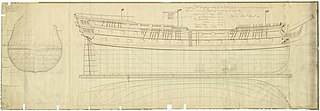
HMS Colossus was a 74-gun third-rate ship of the line of the Royal Navy. She was launched at Gravesend on 4 April 1787 and lost on 10 December 1798. During her years of service she participated in the Battle of Groix, the Battle of Cape St Vincent, and the Battle of the Nile. While carrying wounded from the latter, she was wrecked at the Isles of Scilly. The wreck is a Protected Wreck managed by Historic England.
HMS Ganges was a 74-gun third-rate ship of the line of the Royal Navy, launched in 1782 at Rotherhithe. She was the first ship of the Navy to bear the name, and was the name ship of her class. She saw active service from 1782 to 1811, in Europe and the West Indies.
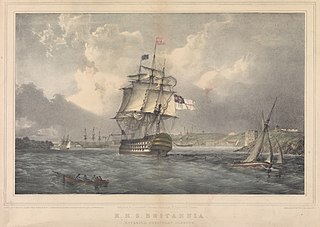
HMS Britannia was a 100-gun first-rate ship of the line of the Royal Navy. The vessel was laid down in 1751 and launched in 1762. Nicknamed Old Ironsides, she served in the American Revolutionary War, the French Revolutionary Wars and the Napoleonic Wars, including at the Battle of Trafalgar in 1805. One of the largest Royal Navy warships of her era, Britannia was one of only three British first-rates present at the battle, alongside HMS Victory and HMS Royal Sovereign. In 1806, the vessel was laid up and eventually converted into a hulk, before being broken up in 1825.

Admiral Sir William Cornwallis, was a Royal Navy officer. He was the brother of Charles Cornwallis, 1st Marquess Cornwallis, British commander at the siege of Yorktown. Cornwallis took part in a number of decisive battles including the siege of Louisbourg in 1758, when he was 14, and the Battle of the Saintes but is best known as a friend of Lord Nelson and as the commander-in-chief of the Channel Fleet during the Napoleonic Wars. He is depicted in the Horatio Hornblower novel, Hornblower and the Hotspur.
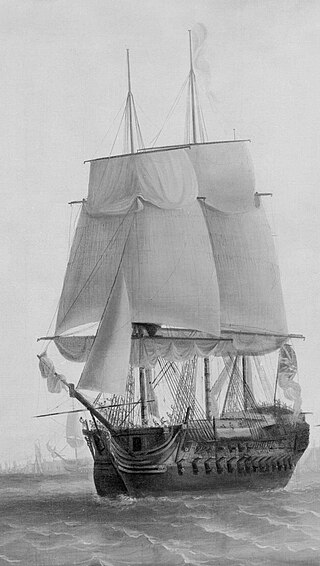
Courageux was a 74-gun ship of the line of the French Navy, launched in 1753. She was captured by the Royal Navy in 1761 and taken into service as HMS Courageux. In 1778 she joined the Channel Fleet, and she was later part of the squadron commanded by Commodore Charles Fielding that controversially captured a Dutch convoy on 31 December 1779, in what became known as the Affair of Fielding and Bylandt. On 4 January 1781, Courageux recaptured Minerva in a close-range action west of Ushant that lasted more than an hour. That April, Courageux joined the convoy under George Darby which successfully relieved the Great Siege of Gibraltar.

HMS Berwick was a 74-gun Elizabeth-class third rate of the Royal Navy, launched at Portsmouth Dockyard on 18 April 1775, to a design by Sir Thomas Slade. She fought the French at the Battle of Ushant (1778) and the Dutch at the Battle of Dogger Bank (1781). The French captured her in the action of 8 March 1795 during the French Revolutionary Wars and she served with them with some success then and at the start of the Napoleonic Wars until the British recaptured her at the Battle of Trafalgar. Berwick sank shortly thereafter in a storm.

HMS Tartar was a 28-gun sixth-rate frigate of the Royal Navy.
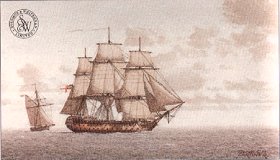
HMS Edgar was a 74-gun third-rate ship of the line of the Royal Navy, that saw service in the American Revolutionary, French Revolutionary and Napoleonic Wars. Launched in 1779, she fought in the battles of Cape St Vincent and Copenhagen, two of the major naval engagements of the wars.
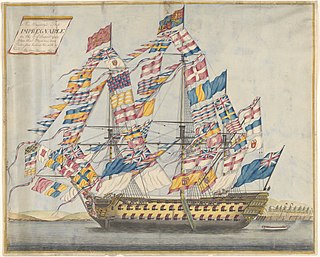
HMS Impregnable was a Royal Navy 98-gun second rate ship of the line launched on 15 April 1786 at Deptford Dockyard. She was wrecked in 1799 off Spithead.
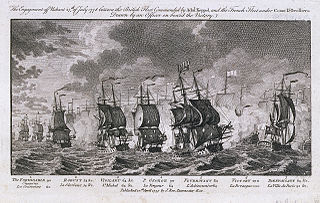
HMS Robust was a 74-gun third-rate ship of the line of the Royal Navy, built by John Barnard and launched on 25 October 1764 at Harwich. She was the first vessel of the Royal Navy to bear the name.

HMS Fortitude was a 74-gun third-rate ship of the line of the Royal Navy, built by John Randall & Co. and launched on 23 March 1780 at Rotherhithe.
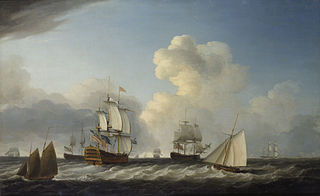
HMS St George was a 98-gun second rate ship of the line of the Royal Navy, launched on 14 October 1785 at Portsmouth. In 1793 she captured one of the richest prizes ever. She then participated in the Naval Battle of Hyères Islands in 1795 and took part in the Battle of Copenhagen in 1801. She wrecked off Jutland in 1811 with the loss of almost all her crew.

HMS Powerful was a 74-gun third rate ship of the line of the Royal Navy. She took part in the defeat of a Dutch fleet in the Battle of Camperdown in 1797, the capture of a French privateer in the action of 9 July 1806, in operations against the Dutch in the East Indies during the raids on Batavia and Griessie in 1806 and 1807, and finally in the Walcheren Campaign during 1809.
HMS Bedford was a Royal Navy 74-gun third rate. This ship of the line was launched on 27 October 1775 at Woolwich.

Fénix was an 80-gun ship of the line (navio) of the Spanish Navy, built by Pedro de Torres at Havana in accordance with the system laid down by Antonio Gaztaneta launched in 1749. In 1759, she was sent to bring the new king, Carlos III, from Naples to Barcelona. When Spain entered the American Revolutionary War in June 1779, Fénix set sail for the English Channel where she was to join a Franco-Spanish fleet of more than 60 ships of the line under Lieutenant General Luis de Córdova y Córdova. The Armada of 1779 was an invasion force of 40,000 troops with orders to capture the British naval base at Portsmouth.

Admiral John Gell (1740–1806) was from the Gell and Eyre families of Hopton Hall in Derbyshire. He served with the Royal Navy, fighting in India and taking part in the occupation of Toulon.

HMS Victory is a 104-gun first-rate wooden sailing ship of the line. With 247 years of service as of 2025, she is the world's oldest naval vessel still in commission. She was ordered for the Royal Navy in 1758, during the Seven Years' War and laid down in 1759. That year saw British victories at Quebec, Minden, Lagos and Quiberon Bay and these may have influenced the choice of name when it was selected in October the following year. In particular, the action in Quiberon Bay had a profound effect on the course of the war; severely weakening the French Navy and shifting its focus away from the sea. There was therefore no urgency to complete the ship and the signing of the Treaty of Paris in February 1763, meant that when Victory was finally floated out in 1765, she was placed in ordinary. Her construction had taken 6,000 trees, 90% of them oak.

HMS Prince William was a 64-gun third-rate ship of the line of the Royal Navy. She had previously been Guipuzcoano, an armed 64-gun ship of the Spanish (Basque) mercantile Guipuzcoan Company of Caracas. She was also known by the religious name of Nuestra Señora de la Asunción.
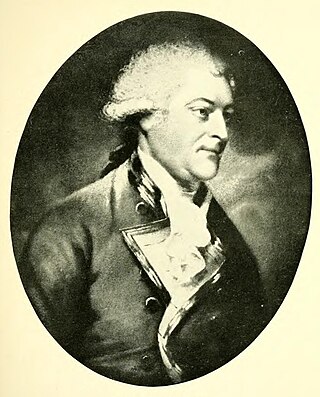
Admiral Robert Linzee was an officer of the Royal Navy who served during the American War of Independence, and the French Revolutionary and Napoleonic Wars.

HMS Romulus was a 36-gun fifth rate frigate of the Flora class, built for the Royal Navy and launched in September 1785. At the outbreak of the French Revolutionary War, Romulus was despatched to the Mediterranean where she joined a fleet under Admiral Lord Hood, initially blockading, and later occupying, the port of Toulon. She played an active role during the withdrawal in December, providing covering fire while HMS Robust and HMS Leviathan removed allied troops from the waterfront.


















